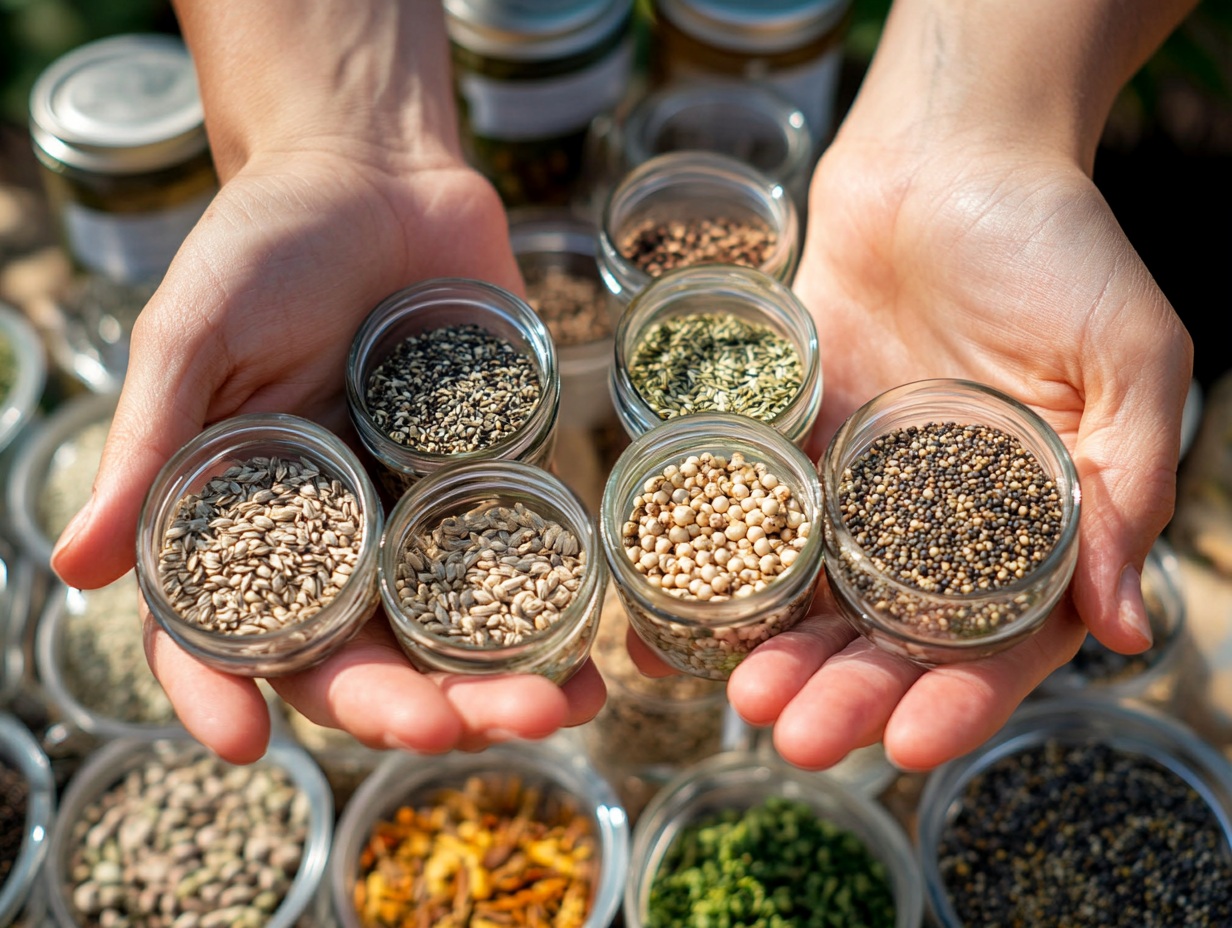The Art of Preserving Your Garden’s Legacy
Saving seeds from your garden is more than just a cost-saving practice; it’s a step toward sustainability and self-reliance. By learning how to save seeds from your garden, you can maintain the quality of your favorite vegetable varieties and pass down a piece of gardening history to future generations. In this guide, we’ll explore the step-by-step process of seed saving, the best practices for storing seeds, and how to choose the right vegetables for seed collection.
Why Save Seeds from Your Garden?
Saving seeds offers numerous benefits that extend beyond your own garden. Understanding these advantages can motivate you to incorporate seed saving as part of your annual gardening routine.
Benefits of Seed Saving
- Cost Efficiency: Reduces the need to purchase seeds each season.
- Biodiversity Preservation: Helps maintain heirloom and open-pollinated plant varieties.
- Adapted Plant Varieties: Seeds from plants grown in your garden are naturally adapted to local conditions, resulting in stronger, more resilient plants.
- Self-Sufficiency: Enhances food security by ensuring you have seeds on hand for future planting.
By saving seeds, you’re contributing to a gardening tradition that promotes sustainability and genetic diversity.
Choosing the Right Vegetables for Seed Saving
Not all vegetables are equally suited for seed saving. Some are easier to collect seeds from than others, and choosing open-pollinated varieties is essential.
Open-Pollinated vs. Hybrid Seeds
The type of plant you grow will determine how successful you are at seed saving:
- Open-Pollinated Varieties: These plants produce seeds that will grow true to type, meaning the offspring will be similar to the parent plant. Examples include heirloom tomatoes and many types of beans.
- Hybrid Varieties: Seeds from hybrid plants often do not produce reliable offspring. These seeds may grow into plants that are different from the parent and may lack desired traits.
Tip: Always choose open-pollinated or heirloom varieties for seed saving. Hybrid seeds, while sometimes more vigorous, are not ideal for this purpose.
Best Vegetables for Beginner Seed Savers
Starting with easy vegetables will help you build confidence in seed saving. Some of the easiest vegetables for beginners include:
- Tomatoes: Simple to ferment and store.
- Peppers: Easy to dry and store.
- Beans and Peas: Dry naturally on the plant and require minimal preparation.
- Lettuce: Produces seeds that are simple to collect and store.
The Step-by-Step Guide to Saving Seeds
Understanding the process of how to save seeds from your garden is essential for success. Each type of vegetable requires specific techniques to ensure viable seeds.
Collecting Seeds from Tomatoes
Tomatoes are one of the most popular vegetables for seed saving due to their simplicity.
- Choose Ripe Tomatoes: Select fully ripe, healthy tomatoes from your best plants.
- Extract the Seeds: Cut the tomato in half and squeeze the seeds into a jar.
- Ferment the Seeds: Add a small amount of water to the jar and let it sit for 2-3 days to ferment. This process helps remove the gel coating on the seeds.
- Rinse and Dry: After fermentation, rinse the seeds thoroughly and spread them on a paper towel or screen to dry.
- Store Properly: Once completely dry, store the seeds in a cool, dark place in a labeled envelope or jar.
Saving Seeds from Beans and Peas
Beans and peas are perfect for beginners because they naturally dry on the plant.
- Let the Pods Mature: Leave the pods on the plant until they turn brown and the seeds rattle inside.
- Harvest and Shell: Remove the pods from the plant and shell them to extract the seeds.
- Dry Further: Lay the seeds on a tray to ensure they are completely dry before storage.
- Store in a Container: Place the seeds in an airtight container, labeled with the date and variety.
Collecting Lettuce Seeds
Lettuce produces seeds quickly, making it a great choice for new seed savers.
- Let the Plant Bolt: Allow the lettuce to flower and go to seed.
- Collect Seeds: Once the flowers have dried and become fluffy, gently shake them over a bowl to release the seeds.
- Clean and Dry: Remove any chaff and ensure the seeds are completely dry before storing.
Saving Pepper Seeds
Pepper seeds are easy to save and store.
- Choose Ripe Peppers: Select fully mature peppers for seed saving.
- Remove and Dry: Cut the pepper open, remove the seeds, and spread them on a paper towel to dry.
- Store in a Cool Place: Once dry, place the seeds in a sealed envelope or container labeled with the date and variety.
Proper Seed Storage Techniques
Storing your seeds correctly is just as important as collecting them. Improper storage can lead to poor germination rates and reduced seed viability.
Best Practices for Storing Seeds
- Cool and Dry: Store seeds in a cool, dry place to prevent moisture from causing mold or rot. A temperature range of 32°F to 41°F (0°C to 5°C) is ideal.
- Airtight Containers: Use glass jars, plastic containers, or seed envelopes to keep moisture out.
- Labeling: Always label your seeds with the date of collection and the variety name. This helps track the age of your seeds, as germination rates decline over time.
- Silica Gel Packs: Adding a silica gel pack to your container can help absorb any residual moisture.
How Long Can Seeds Be Stored?
The viability of seeds varies by plant type. Here are some general guidelines:
- Tomatoes: Up to 5 years if stored properly.
- Peppers: Up to 4 years.
- Beans and Peas: 3-5 years.
- Lettuce: 2-3 years.
Tip: Perform a germination test before planting old seeds to ensure they will grow.
Ensuring High Germination Rates
Maximizing the germination rate of your stored seeds involves careful preparation and testing.
How to Test Seed Viability
To test seed viability, use the following method:
- Dampen a Paper Towel: Place a small number of seeds on a damp paper towel.
- Fold and Seal: Fold the towel and place it in a resealable plastic bag.
- Label and Wait: Label the bag with the seed type and date, then place it in a warm spot.
- Check for Sprouting: After 7-10 days, check to see how many seeds have sprouted. A germination rate of 70% or higher indicates good seed viability.
Tips for Successful Seed Saving
- Harvest from Healthy Plants: Always choose seeds from the healthiest plants in your garden to promote strong future growth.
- Avoid Cross-Pollination: To ensure true-to-type seeds, isolate plants that are prone to cross-pollination, such as squash and cucumbers.
- Dry Thoroughly: Seeds that aren’t dried properly before storage can develop mold and lose viability.
Common Mistakes to Avoid
Avoid these common pitfalls to ensure a successful seed-saving experience:
- Storing Seeds in Humid Conditions: Moisture can lead to mold and decrease seed longevity.
- Collecting Seeds Too Early: Seeds that haven’t fully matured will not germinate well.
- Skipping Labeling: Without proper labels, you may lose track of seed varieties and collection dates.


Leave a Reply